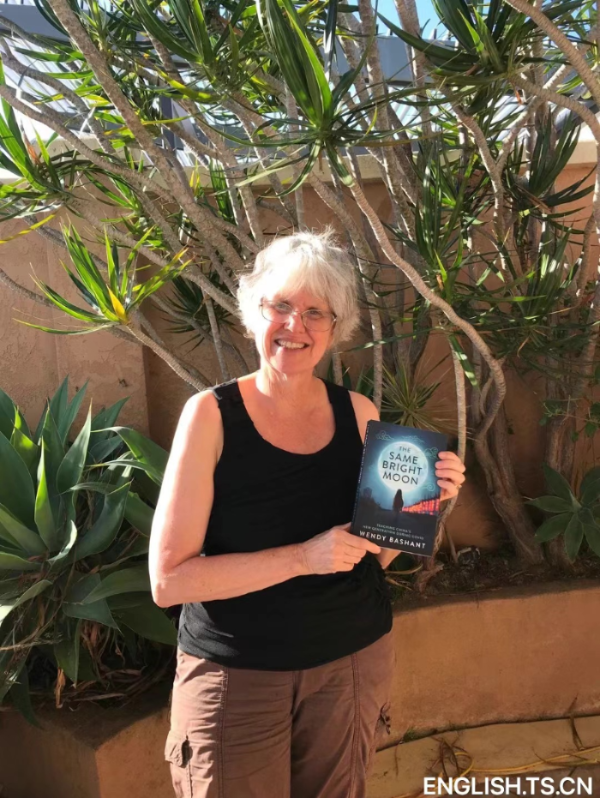Non-native Chinese often think that they know China. They’ve visited Beijing or Shanghai. They know the Forbidden City, the Terracotta Warriors, or the iconic wall, and they think that is all there is. As a teacher at Xi’an Jiaotong University, I was able to meet students who hailed from all parts of the country. The students spoke passionately about their hometowns and villages. From them, I learned of the vastness and variety of China. A number of my students were from Xinjiang. From them, I learned of an area far from bustling cities of China’s east coast.

Wendy Bashant has written travel articles, academic chapters and poetry; her most recent book, "The Same Bright Moon," is about her experience teaching as an expat at Xi'an Jiaotong University.(Photo courtesy of Wendy Bashant)
Xinjiang is China’s largest province — three times the size of France. It borders a number of countries: Mongolia, Afghanistan, Pakistan, India, Kazakhstan, Kyrgyzstan, Tajikistan, and Russia. The southern part is flat and dry, a desert surrounded by a necklace of fertile oases fed by water from the Kunlun mountain range. These green spots are home to agriculture. The central region lies at the fork of the Tianshan Mountains. This area was important during the time of the Silk Road, a web of many trading routes. The north hosts another desert that is shared by herdsmen.
However, one of the top sites to visit in this northern region is Kanas Lake and Scenic Area, a popular spot that offers a deep dose of natural beauty. The area boasts a mosaic of snow-capped mountains, grasslands and forests. Kanas Lake is long and meandering, a thin body of water that curls through towering mountains and lowlands. The lake was carved by glaciers 200,000 years ago. From the air, it looks like a sea-serpent sunning itself in the valleys that wind through the Altai Mountains. Its dark sapphire blue reflects the clear sky. The Altai Mountains are a chain that covers 1,200 miles, stretching through China, Mongolia, and Russia. They start as gentle foothills, but gradually turn to rugged peaks that reach almost 15,000 feet into the deep cerulean sky.
The best time to visit the region is early fall, when the birches turn amber. The reflection of the saffron leaves shimmers in the deepest freshwater lake in China, turning the lake’s surface into something akin to an elegant Tiffany lamp.
The lake offers visitors three popular places to visit, all with evocative names: Wolong Bay, Moon Bay, Fairy Bay. Visiting these bays early in the morning, you can watch the mist rise as the sun slowly burn veils from the swampy meadows. It feels as though you’re in a fantasy game.
In fact, the lake even comes with a myth not unlike Scotland’s Loch Ness monster. For centuries, legends have spoken of large sea-creatures lurking below the surface. Yuan Guoying, with his students from Xinjiang University, observed fish approximately 10-15 meters long. Further research suggests these fish are giant hucho taimen or exceptionally large Siberian salmon-like fish. Others however prefer to believe the ancient myth. The shadowy creatures veiled in mist, glimpsed occasionally by visitors, aren’t fish, but rather undiscovered giant reptiles, a monster rising from the depths, or perhaps a dinosaur left behind from the Jurassic period.
After visiting the bays, you may choose to take a shuttle bus to observation decks above the lake, or hike the wooden trails that connect the scenic points, each offering a unique vantage point of the scenic area. If you choose to climb up to Guanyu Pavilion, you’ll find vast panoramic views of the lake, the forests and the formidable mountains. From above, you can imagine an artist painting the scene before you, spinning myths and the natural world into gold.
Wendy Bashant taught and served for over thirty years as a college dean and professor at University of California San Diego(UCSD) before teaching at Xi’an Jiaotong University in China.
Planner: Jie Wenjin
Reviewers: Hou Weili and Cheng Li









